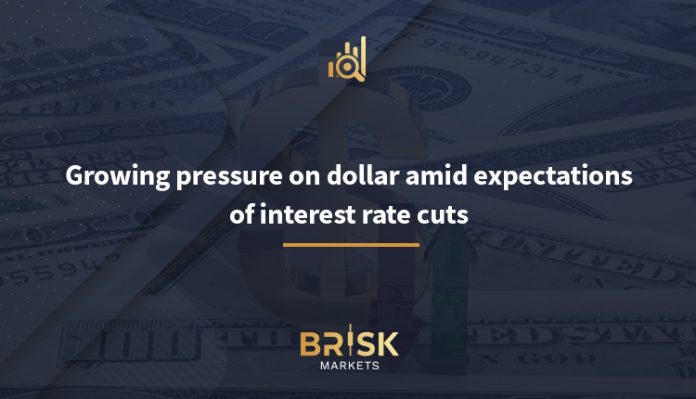The US dollar continues to be under pressure due to President Donald Trump’s protectionist trade policies, especially his aggressive rhetoric and ever-changing stance on tariffs. Trump’s announcement that there are no tariff exemptions on electronic products is creating uncertainty in global markets and continues to undermine investor confidence.
The dollar opened the new week at 100 after falling to 99 last week. However, early trading showed another decline, returning to 99.
This means that the dollar is now at a three-year low. The dollar’s losses are particularly evident against the USD/JPY and USD/CHF pairs. The EUR/USD exchange rate also started testing the 1.14 level, indicating that the dollar is losing its image as a safe investment.
Looking at macroeconomic data, the decline in both the headline CPI and core producer price index data issued in the United States suggests a temporary easing of inflationary pressures. This has increased expectations of a rate cut by the Federal Reserve. While markets estimate the probability of a 25 basis point rate cut in May by 20%, this rate rises to 80% in June.
Markets expect an overall interest rate cut of 80 basis points in the US this year, which could keep the dollar under pressure.
However, the ECB is also expected to cut interest rates by 25 basis points at its meeting on Thursday. This may limit the euro’s gains against the dollar. The ECB is now focusing more on supporting growth than fighting inflation, taking an accommodative approach. This may slow the euro’s rally in the short term and help the dollar achieve some equilibrium.
Trump’s mixed messages increase dollar pressures and volatility
US President Trump’s conflicting messages on tariffs – where he tightens one day and then lowers them the next day – negatively affects investor confidence in US economic policy. This loss of confidence causes short-term fluctuations in the market and even raises doubts about the dollar’s role as the world’s main reserve currency.
The recent controversy over tax breaks on electronic products is another indication of continued uncertainty. President Trump has stated that there will be no waivers, contradicting previous reports that some tech products could be exempted. These discrepancies make it difficult for the market to understand or follow its policies.
At the same time, Trump’s unclear trade stance toward China and aggressive trade moves are putting pressure on the growth outlook for the U.S. economy.
This makes it difficult to determine the right course for monetary policy. The Federal Reserve needs to cut interest rates to support the economy, but it may also need to raise them if inflation rises. These contradictory needs could drain monetary policy tools.
However, some Fed members are trying to calm markets, saying the bank has instruments other than interest rates to manage the economy.
Low inflation provides temporary relief
Lower CPI and PPI data, released last week, put further pressure on the dollar. The year-on-year decline in headline and core inflation eased pressure on the Federal Reserve, at least for now. This repriced expectations of interest rate cuts and paved the way for the dollar index to fall below the 100 level. However, market experts are still unsure if this decline is permanent. There is increasing talk of a “stagflation” scenario, in which growth is slowed by the impact of trade wars, and at the same time this slowdown could lead to higher inflation.
Dollar under pressure and pound regains bullish momentum
The US dollar index (DXY) continued its decline for the third consecutive session, falling below the 100.00 level, and approaching a three-year low of 99.01. This decline reflects growing investor fears of a slowing US economy and a shift in the Federal Reserve’s policy outlook towards quantitative easing.
Mixed data weakens dollar outlook
Economic indicators were uneven. The University of Michigan’s consumer confidence index fell to 50.8 in April, while inflation expectations rose to 6.7 percent. The PPI for March rose 2.7% year-on-year, down from 3.2% in February, suggesting lower input costs.
The Dollar Index (DXY) is under pressure, falling to USD$99.48 after failing to hold above the key support level at USD$100.29. The breakdown below the 1.618 Fibonacci Extension level ($99.83) confirms the continuation of the bearish momentum, with immediate support now stabilizing at $98.95, with deeper consolidation near USD$98.33.
At the same time, resistance is at USD$100.29, followed by USD$101.24 if bulls try to retrace. The 50-year EMA at USD$101.91 and the 200-year EMA at USDA of $103.78 remain steadily above price, reinforcing the bearish bias. Momentum is weak, and sellers are clearly in control. If the US dollar index fails to regain the $100 level, it risks slipping towards $97.55, a key extension level that could trigger further volatility ahead of the release of US macroeconomic data. The artistic picture of the dollar remains fragile. Traders should keep an eye on any rebound above the $100.29 level to assess short-term shifts in sentiment.
GBP/USD Technical Analysis
The British Pound (GBP/USD) is on a quiet but masked rally against the US dollar, currently trading at $1.3169, touching the upper band of an ascending price channel.




